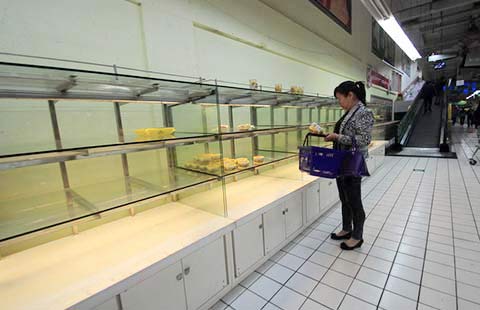PBOC offers emergency funds to banks amid latest cash squeeze
(Agencies) Updated: 2014-01-21 10:02Bankers say the central bank is using higher money market rates as a tool to curb explosive growth in economy-wide debt since 2008, especially off-balance sheet credit that banks often fund through interbank borrowing.
In addition to the support for big banks and the planned injection on Tuesday, the central bank will also offer overnight, seven-day, and 14-day funds to smaller banks via SLF, it said in an announcement on its website.
The PBOC will offer up to 120 billion yuan ($19.8 billion) in funds to smaller banks through this channel, according to a central bank document obtained by Reuters.
Analysts say smaller banks rely the most on money-market funding because their smaller branch networks provide them less access to customer deposits.
The sources said banks incorporated at the regional or local level can apply to the PBOC for fund injections via SLF when the interest rate on the overnight bond repurchase rate exceeds 5 percent, the seven-day repo rate exceeds 7 percent, or the 14-day repo rate exceeds 8 percent, according to three sources with direct knowledge of the new policy.
Those thresholds will remain in effect through the Lunar New Year holiday which starts on January 31. After that the expanded SLF mechanism will remain in place for small banks but the thresholds could change, the sources said.
A PBOC spokesman declined to comment.
The central bank previously used its SLF to provide one- to three-month loans to commercial banks. The latest expansion offers cash injections of 14 days or less.
The overnight repo rate closed at 4.30 percent on a weighted-average basis on Monday but individual trades occurred as high as 9 percent.
The seven- and 14-day rates peaked on Monday at 10 percent and 7.8 percent, respectively, according to data from the National Interbank Funding Center.
Traders attributed the higher rates to elevated cash demand in the run-up to the New Year holiday.
The relaunch of initial public offerings of stock is also boosting cash demand this week. IPOs, restarted last week after a 14-month freeze, drive demand for short-term funding as investors need to deposit funds with underwriters in order to subscribe to new listings.
Eight companies said on Monday that they would list on the Shenzhen Stock Exchange on Tuesday, the first listings on China's smaller bourse since the freeze ended.
Traders had previously predicted funding conditions would tighten in late January. The latest funding squeeze follows severe cash crunches in late June and late December.
The seven-day rate peaked at 28 percent on June 20, the highest trade on record, and soared again to 10 percent on December 20 and 23.
- NHTSA says finds no 'defect trend' in Tesla Model S sedans
- WTO rare earth ruling is unfair
- Amway says 2014 China sales may grow 8%
- President Xi in Europe: Forging deals, boosting business
- CNOOC releases 2013 sustainability report
- Local production by Chery Jaguar Land Rover this year
- Car lovers test their need for speed in BMW Mission 3
- China stocks close mixed Monday

















